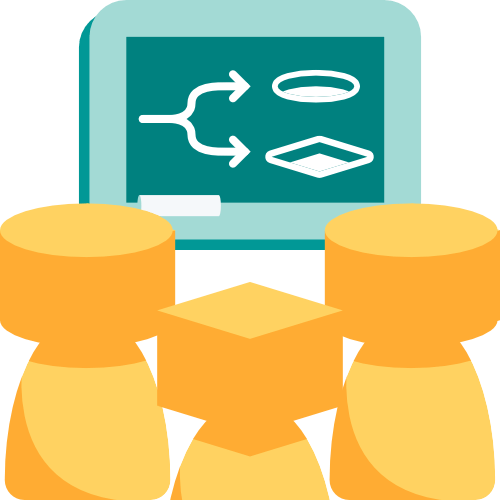Explained: Differentiation and Adaptive Teaching
Author: Brooke Marsden
Brooke is a member of Yipiyap’s Leadership Team and a former peer tutor, channelling her love of education into improving outcomes of learners nationwide. As a graduate of English and Creative Writing, she loves researching new ideas and presenting them in an imaginative way.
At Yipiyap, we’re proud to be able to introduce so many young people to the world of teaching. Many of our gap year tutors have gone on to careers in education - and for those who don’t, they step up to their future career with essential teaching and learning skills.
In our new Explained series for 2024, we’re going to shed some light on the key pedagogical terminology for fledgling educators - and maybe even provide a refresher for seasoned teachers too!
What is differentiation in education?
Differentiation in teaching is an approach characterised by pre-planning work of tiered difficulty for students. This might be ringing a bell to younger readers thinking back to school, with the high achievers being handed a different worksheet to everyone else. The core premise of differentiation strategies is that a one-size-fits-all take on the classroom fails to adequately challenge and support each student’s needs.
To support learners, teachers implement different techniques and explanations to accommodate these varying levels of abilities. For example, presenting the material in a variety of ways to accommodate for the visual learner, the auditory learner, or the kinaesthetic learner. This might look like demonstrating how to tackle a question on the whiteboard, explaining it using a variety of vocab, or using blocks to represent it.
By proactively planning a variety of approaches matched to learning abilities in the room, teachers can group students by work that matches them!
Types of Differentiation
What is adaptive teaching?
Adaptive teaching is a term coined by radical behaviourist BF Skinner. Those familiar might wince at the name - but no-one is suggested you should keep your learners in a box!
Skinner believed in the power of positive reinforcement, being open about errors, and for teachers to continue learning and evolving as teachers long after they get their first class. After all, if our students come in to learn every day, sounds pretty fair that we should as well, right?
In adaptive teaching, teachers and tutors adjust their curriculum and approach to respond to student needs in real-time. An example of this strategy is noticing a few students that seem confused and taking time to sit with them as a group and clear up any misconceptions while the rest of the class get started on questions or worksheets.
If you want to be more in-tune with what your students really understand from a lesson - adaptive teaching is here to help.
Frequent assessment (NB: that’s the pedagogical assessment - not just tests!) and dialogue with students feed into how you can modify the way you deliver content and amend the level of difficulty of the work to suit the needs of learners.
It might seem like a greater effort at first - but adaptive teaching provides scaffolds where necessary so that all students can access the material being taught, and then empowers them to be curious and engage with the content. No more walls of blank faces when a question is thrown out to the class!
Adaptive Teaching vs. Differentiation
While effective teaching often integrates elements of both approaches, the key difference between adaptive teaching and differentiation in the classroom lies in the planning and reactivity of educators.
Differentiation’s weakness is that it relies on the ability to predict how students will understand and engage with work ahead of time and has been the traditional approach for teaching an entire class together. Whereas adaptive teaching strategy is reactive and in-the-moment, hence why it’s become so popular in recent years!
The Education Endowment Foundation encourages educators to try adaptive teaching as a way of maintaining high expectations, citing that there is a danger of an ‘expectation ceiling’ in old-school differentiation. If students are frequently placed into a bottom group, for instance, this ‘may lead to a lowering of expectations’ for themselves and decreased self-confidence, outweighing the benefits of differentiated learning.
Positives of adaptive teaching strategies:
Still not sold? Here are four ways adaptive teaching benefits your learners:
Meets all students at their personal readiness level: Differentiation often uses the ‘All, Most, Some’ method to set groups from low to high ability. Adaptive teaching sets a high target for everyone, and then takes targeted steps to help each student reach it.
Addresses gaps in learning in real-time: Adaptive teaching allows for more time to be spent on understanding concepts. So, when it comes to revisiting topics, during a revision period for example, students do not feel they must ‘self-teach’ without having understood the concept with the support of teaching staff.
Improves student motivation and self-confidence: Students can feel more involved in learning knowing that their teacher is in tune with their level and welcomes questions.
Promotes efficient personalized learning: If students can start to recognise their own patterns which prevent them from understanding, it provides them the scaffold for them to start noticing their own errors and self-correcting. This scaffold can then be slowly taken away until the students can approach their learning independently - so you’ll be teaching metacognition as a by-product!
What does Ofsted say about adaptive teaching?
Not only does Ofsted now highlight this way of tailoring education in its assessment objectives, it is also now recognised a part of the Department for Education’s Early Career Framework and the Teachers’ Standards.
Ofsted measures quality in education using three metrics: content knowledge, pedagogical knowledge, and pedagogical content knowledge. Adaptive teaching ties into all three – which is why you’ll want to give it a try! So, when it comes to this style of supporting puppils, Ofsted is on board.
Implementing adaptive teaching strategies
Examples of adaptive teaching
Okayyy, you might be thinking, now I know who adaptive teaching came from and why it’s so good, but what does it actually look like in practice? Here are a couple of adaptive teaching examples.
During a Maths lesson, the teacher realizes a few students are confused and pulls them over for targeted remediation while other students begin worksheets independently. This way, those students can rejoin the class after and continue, now clearer on how to approach the task. Seems simple, doesn’t it? It is!
The skill lies in knowing and understanding your students, as well as being compassionate to all levels of abilities. This is where the blend of differentiation methods and adaptive teaching comes in - adaptive teaching can use the ‘All, Most, Some’ framework when based directly on assessment data. For example, if a class all take a reading comprehension assessment, then tiered reading groups can be made based on their performance, focussing each group on a different comprehension skill that will be useful to them specifically.
How does support in the classroom aid adaptive teaching?
You may be thinking, ‘this sounds great, but I don’t have the time to take groups aside and re-explain a concept’. This is where tuition comes in…
One to one or small group tuition provides the perfect environment for teachers to facilitate adaptive, responsive learning. With closer teacher-student or tutor-student ratios, you can better monitor students’ progress, identify when learners are struggling or need more of a challenge, and make immediate adjustments. In any case, having an extra pair of hands on deck means higher students can be challenged and lower students can be supported!
Basically, you and each individual student must learn to understand why they think the way they do. A learner that has been getting foundational maths wrong simply may not understand what the word ‘multiply’ means; a misconception that is easily explained in minutes of close contact time, and can make a world of difference in terms of marks and learner wellbeing.




